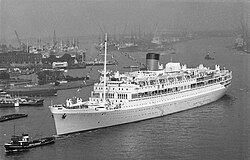Angelina Lauro (ship)
|
The Orange , 1960 in Amsterdam
|
||||||||||||||||||||||
|
||||||||||||||||||||||
|
||||||||||||||||||||||
|
||||||||||||||||||||||
|
||||||||||||||||||||||
|
||||||||||||||||||||||
The Angelina Lauro - Oranje until 1964 - was a passenger ship built from 1937 to 1939. When it was delivered it was the most powerful motor ship in the world.
history
The Oranje was commissioned by the Amsterdam shipping company Stoomvaart Maatschappij "Nederland" as the type of a three-series ship . Construction at the Nederlandse Scheepsbouw Maatschappij in Amsterdam began in 1937, the launch followed on September 8, 1938. On July 15, 1939 the finished ship was delivered to the client and shortly afterwards put into service on the line from Amsterdam via Cape Town to Batavia. At the beginning of the Second World War, the Orange was first launched in Surabaya . The ship was later made available to the Royal Australian Navy and, after being converted in 1941, served as a hospital ship with a Dutch crew.
In the years from 1947 to 1957 the ship was used again between Amsterdam and Batavia. On January 6, 1953, the Oranje collided in the Red Sea with Willem Ruys , who was in the same service , and no people died, but both ships suffered major damage in the forecastle. In 1958 and 1959 the ship served on the route from Amsterdam and Southampton through the Suez Canal via Singapore to Australia. On September 7, 1960, after an overhaul, the ship began a global service from Amsterdam via Australia, New Zealand, Panama Canal, Port Everglades, Bermuda and Southampton back to Amsterdam, which continued from February 26, 1961 to May 4, 1964 in the opposite direction has been.
At the beginning of the 1960s, the number of passengers fell noticeably, after which the ship was sold together with the Willem Ruys to the Italian shipping company StarLauro . This previously operated two significantly smaller ships, the Roma and the Sydney . The Oranje was rebuilt at Tirreno Shipyards, renamed Angelina Lauro and used again on the route between Europe and Australia. In 1977 Costa Crociere chartered the ship for three years and operated it on cruises from Port Everglades to the Caribbean. On March 30, 1979, the now forty-year-old ship caught fire at the pier in Saint Thomas on the Virgin Islands and burned out in the days that followed. The ship was declared a total loss and lifted on July 2, 1979 by the Hamburg ship scrapping company Eckhardt & Co. In this state it formed the backdrop for a scene in the episode Adventures in the Caribbean - Part 2 from the series Charlie's Angels . On July 30, 1979, the towing journey began on the Japanese ship Nippon Maru to the demolition yard in Kaohsiung. On September 21, 1979, the ship began taking water and listing, after which it sank on September 24.
technology
The shipbuilding plans for the Oranje came from HN Prins, the machinery was designed by AH Ijsselmuiden - both engineers at Stoomvaart Maatschappij "Nederland". The ship had a particularly distinctive hull shape for a number of reasons. While the high cruising speed on the one hand required a sharp underwater shape, on the other hand the underwater hull had to have a certain minimum width, as shallow drafts were necessary for the port call in Asia. At the same time, high but not too heavy superstructures were planned, which in this area only had outside cabins, which is why Prins' pulled the hull cross-section clearly inwards on the four decks above the waterline. The technical features of the passenger facilities included, for example, insulation, partial air conditioning or the use of adjustable neon lighting. Another novelty were the bilge keels , which consisted of a large number of fins arranged one behind the other. The Oranje is the first ship with this design after the two Dutch torpedo boats G.15 and G.16 , on which the engineer W. Rösingh from the Wilton-Fijenoord shipyard tested their new form.
The drive system consisted of three Sulzer twelve-cylinder two-stroke diesel engines built in Winterthur with a total output of 37,500 hp. The three engines acted directly on three fixed propellers. On the test run in July 1939, the ship reached a speed of 26.3 knots - at the time the highest speed of a motorized passenger ship in the world. The on-board energy was supplied by five auxiliary diesels, each with an output of 1,200 hp, also supplied by Sulzer.
literature
- Carl Züblin: The main propulsion system of the Dutch three-screw motor ship “Oranje” . In: Werft * Reederei * Hafen . Vol. 20, No. 5 , March 1939, p. 77-79 .
- Motorized passenger ship "Oranje" of the Stoomvaart Mij. "Nederland", built by the Nederlandsche Scheepsbouw Mij., Amsterdam . In: Werft * Reederei * Hafen . Vol. 20, No. October 20 , 1939, p. 316-323 .
Web links
Individual evidence
- ↑ SMHD, Oranje (English)
- ^ Lloyd's Register
- ^ Nederland Line's new Ship in: The Singapore Free Press and Mercantile Advertiser , July 14, 1939, p. 10.
- ↑ W. Rösingh: Roll dampening experiments with Hr.Ms. Torpedo boats "G.15" "G.16" . In: Werft * Reederei * Hafen . Vol. 20, No. January 2 , 1939, p. 19-21 .

